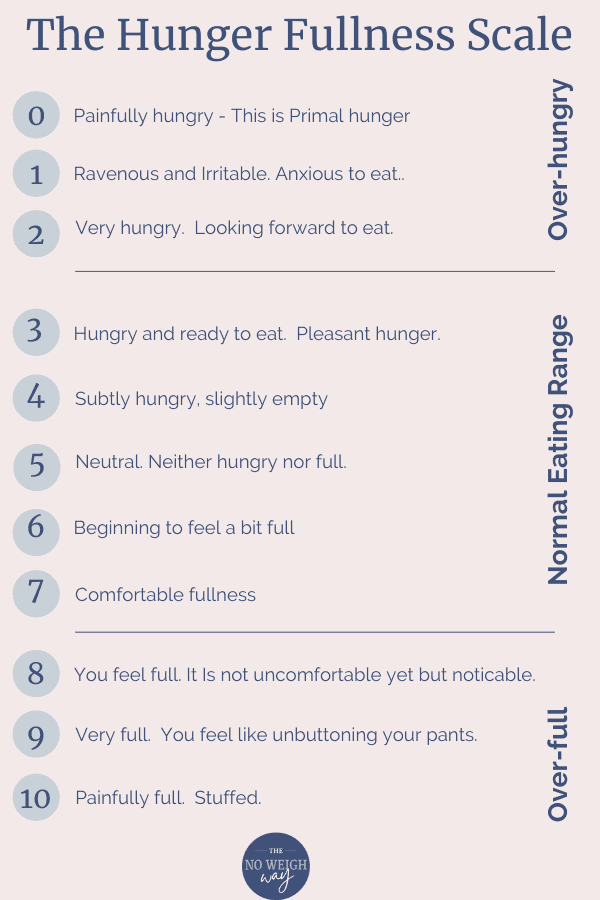
“I have NO idea what it feels like to be hungry.”
Interestingly, this is not an uncommon statement I hear. One of the first things I introduce is the hunger fullness scale for Intuitive Eating. As a Certified Intuitive Eating Practitioner, I have learned that I have to go back to the basics when someone begins their journey. It is crazy how much has been dismantled inside of us after years of following diet culture and not our own biological cues.
Let’s break down how and why the hunger fullness scale is a fantastic tool to utilize.
Hunger and Interoceptive Awareness
Do you know what it feels like when you have to pee?
I bet you have never heard that question before! Stay with me. It will make sense.
Hunger is a biological sensation that cues our body that we need food. We NEED hunger. Just like you need to know what it feels like to have to pee before it is running down your leg. These physical sensations that arise in our bodies are called interoceptive awareness.
Interoceptive awareness is a powerful and innate ability, which includes perceiving the physical cues of hunger and satiety, bodily states such as rapid heartbeat and a full bladder, and the physical sensations produced by emotions.
the INTUITIVE EATING WORKBOOK evelyn tribole & Elyse Resch
New Harbinger Publications 2017
It is not uncommon for people to be angry at their internal hunger cues. It is not uncommon for people to push these biological cues AWAY because they are following external rules of when they are allowed to eat based on some meal plan or diet/lifestyle. And after years of this, our hunger cues can be drastically diminished and in some cases, absent.
So, what do we do?

What Does Hunger Feel Like?
The majority of people that start Intuitive Eating have a desire to heal their relationship with food. Honoring your hunger is a crucial step to this healing. But, what does hunger feel like to you? There are so many ways we can experience hunger. Look at this list below of ways to experience hunger and see what resonates with you.
- STOMACH: This is not limited to just tummy “rumbles”. It can be gnawing or emptiness or even nausea. These sensations are the most common but some people do not experience sensations in their stomach.
- THROAT AND ESOPHAGUS: Gnawing. Can have a dull ache.
- HEAD: Lightheaded, cloudy thinking, headache, trouble concentrating. Lots of thoughts of food!
- MOOD: IRRITABLE!! Just cranky and snappy.
- ENERGY:Low energy. Sleepiness not uncommon.
- NUMBNESS: Overall lethargy.
As you go about your day, take some inventory of how YOU feel when you have gone a few hours without eating. Jotting it in your phone or a journal is a great activity to get some information.
The Hunger Fullness Scale for Intuitive Eating
Disclosure: This section contains Amazon affiliate links. As an affiliate, I earn a commission on qualifying purchases.
To really get dialed in on the nuances of YOUR hunger, we have a tool you can use. As they say, practice makes perfect so this is a great way to practice BUT we do NOT need perfection – just awareness. This tool is a way to check in with your hunger. It will make you hyperconscious of the sensations in your body and it may surprised you how many you have ignored.
The Hunger Fullness scale uses a classic rating system of 1-10 where 0= painfully hungry and 10= painful fullness. There is NO “right or wrong” – it just is. Do not overthink it. I suggest that my clients do this several times throughout the day and before and after they eat any snacks or meals.
Here is a great visual for you to have for the hunger fullness scale.

So, Now What?
Intuitive Eating is a process. Learning to not only FEEL your hunger but honor it, are crucial steps. This summary will help you to tackle those steps. This may come easy to some, and it may be quite challenging to others. It is not a one size fits all process. If you do not have hunger cues at all, or not now, that is ok. You may be someone who has to learn to eat more “mechanically”. What I mean by that is to make sure you do not go longer then 4-5 hours without eating.
If you are in recovery for an eating disorder and have more nutritional rehabilitation to do, you may be required to eat every 3 hours. This should be discussed with your eating disorder medical professional.
To learn more about the other aspects of Intuitive Eating, check out my Beginners Guide To Intuitive Eating.

